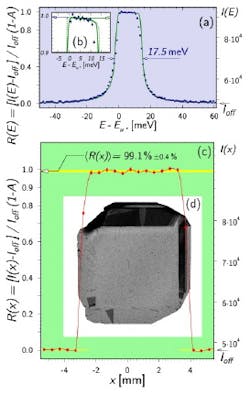Chicago, IL--Argonne National Laboratory researchers have demonstrated that diamond can directly reflect hard x-rays. Via Bragg diffraction, high-quality synthetic diamond crystals can reflect more than 99% of hard x-ray photons at normal incidence with high uniformity across the crystal.1 The discovery should benefit hard x-ray telescopes and physics experiments.
Hard x-rays cam be made to reflect at close to 100% reflectivity from other types of mirrors, but only at grazing-incidence angles (on the order of 89 degrees from the normal or more). This makes for extremely large mirrors and, if focusing is required, very complex optics. Diamond normal-incidence mirrors could make x-ray optics much more like conventional reflective optics.
The researchers used high-brightness x-rays at the at Argonne National Laboratory's Advanced Photon Source. The work was conducted by a team comprising investigators from Argonne National Laboratory and the Technological Institute for Superhard and Novel Carbon Materials (TISNCM) in Russia. This investigation was motivated by the need for high-reflectivity x-ray mirrors at close-to-normal incidence for use in x-ray free-electron-laser oscillators (XFELOs).
XFELOs will provide scientists with fully coherent x-rays that have record-high spectral purity and average brightness, qualities that are highly desirable for experiments. Unlike high-gain x-ray lasers, XFELOs are designed to be low-gain machines, requiring a low-loss optical cavity with high-reflectivity x-ray mirrors close to backscattering, similar to conventional tabletop lasers.
The feasibility of XFELOs was questioned by many experts because of the high-reflectivity x-ray mirror limitations. These limitations are now removed by the new demonstration. Theoretical analysis shows that diamond has the highest (higher than any other crystal) Bragg reflectivity, due to the uniquely small ratio of the extinction length in Bragg diffraction to the absorption length. Even in backscattering, where the reflectivity is lowest, it was thought to be more than 99%—which has now been demonstrated.
For the experiment, synthetic-diamond single crystals of very high crystal quality were grown at the TISNCM via the temperature-gradient method under high-pressure and high-temperature conditions. The reflectivity measurements were performed at the X-ray Science Division beamlines 30-ID and 7-ID at the APS, using 23.7-keV and 13.9-keV photons, respectively.
The results in this study support a broad range of potential applications of diamond crystals for high-reflectance, coherence-preserving, and resilient x-ray optics such as x-ray monochromators, beamsplitters, delay lines, high-finesse Fabry-Perot resonators, and others.
Source: Argonne National Laboratory
REFERENCE:
1. Yuri Shvyd’ko et al., Nature Photonics (published online August 2011); DOI:10.1038/nphoton.2011.197

John Wallace | Senior Technical Editor (1998-2022)
John Wallace was with Laser Focus World for nearly 25 years, retiring in late June 2022. He obtained a bachelor's degree in mechanical engineering and physics at Rutgers University and a master's in optical engineering at the University of Rochester. Before becoming an editor, John worked as an engineer at RCA, Exxon, Eastman Kodak, and GCA Corporation.
